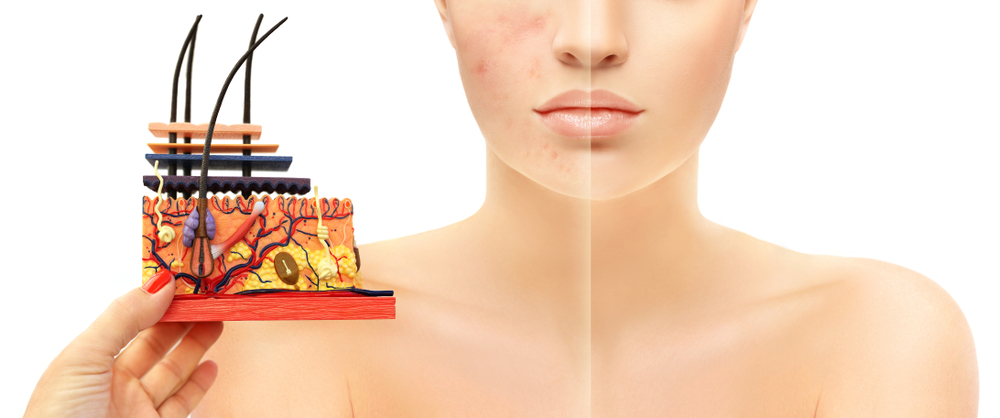The Impact of Diet on Rosacea
The Impact of Diet on Rosacea
Rosacea is a chronic, inflammatory skin disorder that mainly affects the central facial skin like the cheeks, nose, chin, and forehead. It’s a skin condition more common among fair-skinned individuals and from northern European or Celtic ancestry. This condition is more common in women and usually starts between 30 and 50 years of age. Symptoms of this condition are;
- Sensitive skin
- Pertinacious facial erythema
- Swollen skin
- Papules and pustules associated with acne-like breakouts
- Visibly broken blood vessels (telangiectasia)
- Recurrent flushing.
Also, it can include eye findings called ocular rosacea, skin surface changes over time, and phymatous changes known as rhinophyma (bulbous nose).
These symptoms can last for weeks or months at a time, leaves, and then return. Based on their characteristics, rosacea is of four types.
- Subtype 1: Erythematolangiectatic rosacea is associated with sensitive skin, redness, flushing, and visible blood vessels.
- Subtype 2: Papulopustular or acne rosacea is associated with acne like-breakouts, oily and sensitive skin, and broken blood vessels.
- Subtype 3: Rhinophyma is associated with thickening of the skin on the nose, large pores, visibly broken blood vessels, and bumpy skin texture. It is more common in men and often accompanied by another subtype of rosacea.
- Subtype 4: Ocular rosacea is associated with dryness, burning, itching, redness, photophobia, tearing, and blurred vision.
Because of these symptoms, rosacea may cause low self-esteem, embarrassment, anxiety, depression and may affect the quality of life.
Presently, the occurrence of rosacea across the population ranges from 1 to 22 percent. The causes for rosacea remain uncertain, but genetics, the presence of microorganisms such as Demodex folliculorum, dysregulation of the immune system, vascular and neuronal dysfunction can be responsible for the condition. Also, some environmental factors that may cause flushing and worsen rosacea symptoms are;
- UV radiation
- Hot temperatures
- Alcohol consumption
- Physical exercise
- Diet.
Certain foods may act as rosacea triggers, while some can be helpful in the treatment of rosacea. Here is how diet can impact rosacea.
The Rosacea Triggers
In a study carried out by the National Rosacea Society of over 400 patients, 78% altered their diet due to rosacea; and of this group, 95% reported a reduction in flares. Generally, hot non-alcoholic beverages like tea and coffee act as triggers in rosacea patients. Also, spicy foods, hot sauce, cayenne pepper, and red pepper are other triggers because these foods contain a substance called capsaicin that rapidly causes an inflammatory reaction in the skin.
Cinnamaldehyde found in tomatoes, citrus, cinnamon, and chocolate can act as a trigger for rosacea too.
These foods contain substances that can activate some receptors and cause flushing, inflammation, and vasodilatation. A diet that is high in fat can cause an imbalance in the synthesis of cutaneous ceramides and hyaluronic acid, which damages the epidermal barrier and it's known that damages in the skin barrier can influence the development of rosacea. Also, high fat-diet may promote chronic skin conditions related to rosacea. So, if you have rosacea, you have to investigate your diet and see if you are not eating a possible trigger. Using a food diary may help you find out if your rosacea has a relationship with your diet.
4 Foods that can Improve Rosacea
1. High Fiber and Probiotic Foods
It is essential to know that there is a close relationship between rosacea and gut diseases. A study shows that diseases like ulcerative colitis, celiac disease, Chron’s disease, Helicobacter pylori infection, small intestinal bacterial overgrowth, and irritable bowel syndrome were higher in patients with rosacea. With this report, it’s essential to take care of your gut and gut microbiome by consuming a fiber-rich diet.
Consuming dietary fibers present in fruits and vegetables will ensure the growth of a diverse and healthy gut microbiome. Probiotic foods like yogurts, kefir, miso, kimchi, sauerkraut, kombucha, and supplements may help because they can change the composition of gut bacteria, help to counter pathogenic bacteria, demonstrate an anti-inflammatory effect, and impact the skin barrier.
2. Dairy foods
Dairy products can help an individual with rosacea as they can help regulate the gut microbiome and reduce the permeability of the intestinal epithelium, resulting in decreased intestinal inflammation that could be found in people with rosacea.
3. Omega 3-fatty acids
Omega-3 fatty acids are polyunsaturated fatty acids which include eicosapentaenoic acid (EPA), docosahexaenoic acid (DHA), and alpha-linolenic acid (ALA). EPA and DHA have an anti-inflammatory impact; this is evident through a study that showed improvement in people with dry eye symptoms after using omega-3 fatty acids.
4. Curcuma species
It’s common to use Curcuma species in treating inflammation and skin wounds. Curcumin is a polyphenol obtained from Curcuma longa rhizomes, and it has anti-inflammatory and antioxidant actions. Some research have shown that the use of oral Curcuma species can prevent and treat skin redness, loss of water content, and lesions commons in people with rosacea.
In conclusion, it’s vital to take care of your diet if you desire healthy skin and you have rosacea. Consult a dermatologist to help you find the best treatment for your skin and make dietary changes recommended by a registered dietitian.
Written by: Marianne Rocha Taglione
MSc in Public Health and Nutritionist.








Comments (0)